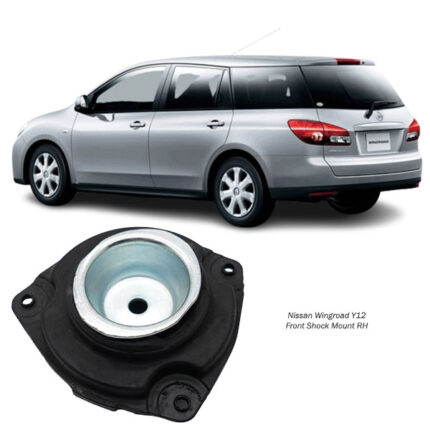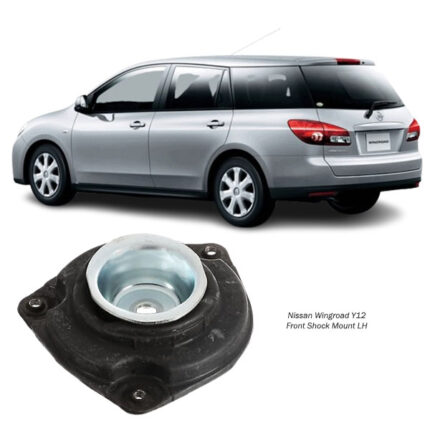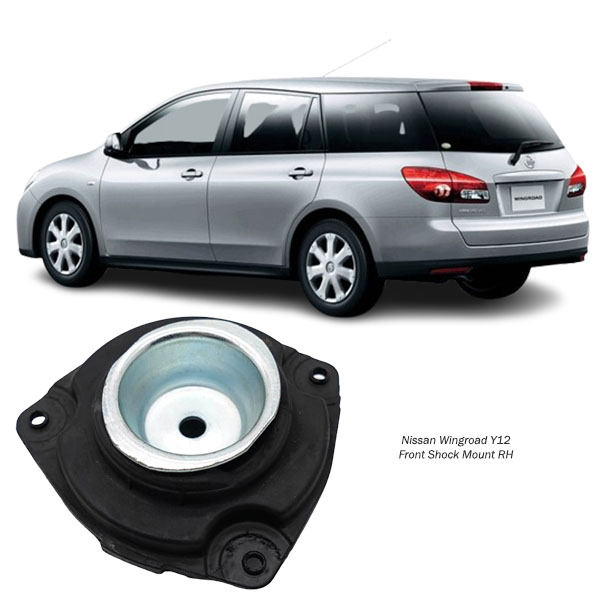-10%
Get Nissan Wingroad Y12 Front Shock Mount RH 54320-ED001 in Kenya
When it comes to vehicle suspension, most people tend to think about shocks, springs, and control arms. But behind the scenes, there’s another essential part making sure everything stays secure, aligned, and functional—the Front Shock Mount RH (Right-Hand). While small and often overlooked, this component plays a major role in how your car rides, steers, and absorbs road impacts.
Let’s break down the details of this critical part—how it works, its function, signs of wear, and why maintaining or replacing it is key to a stable and comfortable ride. 💡🔧
🧱 What is a Front Shock Mount RH?
The Front Shock Mount RH is the upper connection point where the right front shock absorber or strut assembly meets the vehicle’s body or chassis. It acts like an anchor, allowing the shock absorber to function properly by holding it firmly in place while cushioning the impact between the suspension and the vehicle frame. 🛡️
In vehicles with MacPherson strut suspension, the mount also contains a bearing that allows the strut to pivot as the wheels turn, making it even more critical for smooth, accurate steering.
👉 The “RH” simply means Right-Hand side—referring to the passenger side in most left-hand drive vehicles.
⚙️ The Role of the Front Shock Mount RH
Even though it’s small, this component is incredibly important. Here’s what it does:
1. Holds the Shock or Strut in Position
The shock mount secures the upper part of the shock or strut to the car’s frame, helping the suspension move up and down while absorbing road vibrations and impacts. 🛞
2. Absorbs Noise and Vibration
With a rubber or polyurethane insulator, the mount absorbs vibrations and road noise, creating a quieter, smoother ride inside the cabin. 🔇
3. Allows Steering Movement (Strut Bearing)
In strut assemblies, the shock mount includes a built-in bearing that rotates with the wheels when turning. This contributes to light, responsive steering. 🔁
4. Maintains Alignment
A strong mount ensures your shock remains properly aligned, helping preserve correct suspension geometry and preventing uneven tire wear. 🎯
🧩 Components of the Shock Mount
A front shock mount is more than just a bracket. It typically includes:
-
Rubber or Polyurethane Insulator – Damps vibration and prevents metal-to-metal contact.
-
Metal Backing Plate or Housing – Holds everything together structurally.
-
Bearing (in strut mounts) – Allows the mount and strut to rotate with the steering system.
-
Mounting Studs or Bolts – Connects the mount to the vehicle chassis securely.
Together, these parts allow your shock absorber to compress and rebound while keeping everything smooth, quiet, and safe.
🧠 Why the RH Shock Mount is Crucial
While both front shock mounts (LH and RH) are important, the right-hand side often gets exposed to more potholes, gutters, and road debris, especially in countries where the passenger side is closer to the roadside. This means it might wear faster and needs more attention during inspections.
Let’s look at the key benefits of a healthy RH shock mount:
✅ Keeps your shock absorber securely in place
✅ Enhances comfort by absorbing harsh vibrations
✅ Reduces steering effort and noise
✅ Helps prevent excessive tire wear
✅ Supports overall suspension performance
🚨 Signs of a Worn or Failing Front Shock Mount RH
Over time, the rubber in the mount can degrade, crack, or collapse, while the bearing may seize or wear out. Here are common signs your RH shock mount might need replacing:
🔊 1. Clunking or Knocking Noises
Heard from the front right side when going over bumps or uneven roads? That’s often the shock moving within a worn mount.
🧭 2. Steering Creaks or Stiffness
If you notice creaking when turning the steering wheel, especially at low speeds, it could be due to a failing strut bearing inside the mount.
🌪️ 3. Excessive Vibration
Increased vibration or harshness felt on the passenger side could be the mount failing to cushion road impacts.
👀 4. Uneven Tire Wear
A misaligned or unstable mount can cause the strut to shift slightly, leading to premature wear on the front right tire.
🛠️ 5. Visible Damage
During an inspection, cracks, dry rot, or collapsed rubber in the mount are clear indicators it’s time for replacement.
🔧 Replacing the Front Shock Mount RH
Replacing a shock mount is a precise job that typically involves removing the entire shock or strut assembly. Here’s a general overview of the process:
Step 1: Lift the Vehicle 🚗
The right front side is raised and the wheel is removed to access the suspension.
Step 2: Remove the Strut or Shock Assembly 🔩
The assembly is disconnected from the steering knuckle and upper mounting point.
Step 3: Compress the Coil Spring 🌀
If it’s a strut, the spring must be compressed using special tools to safely remove the mount.
Step 4: Install the New Shock Mount 🔄
A fresh mount is installed, often along with a new bearing and insulator if needed.
Step 5: Reassemble and Torque Everything Securely 🔧
The strut is reassembled and reinstalled, and all bolts are tightened to factory specs.
Step 6: Wheel Alignment (Recommended) 🎯
To ensure everything sits perfectly, an alignment may be needed after the job is done.
🆕 When Should You Replace It?
There’s no fixed lifespan, but most mechanics recommend inspecting or replacing the mount when:
-
Replacing shocks or struts (ideal to do both together)
-
Suspension noises begin
-
Vehicle reaches 80,000–120,000 km of usage
-
Regular road conditions are rough (potholes, speed bumps, off-road)
Waiting too long can cause damage to other suspension parts and increase the cost of repairs. 🔁🧾
🔍 OEM vs Aftermarket Options
When replacing a front shock mount, quality matters. You can choose between:
🔹 OEM Mounts
-
Made by the vehicle manufacturer
-
Best fit and performance
-
Great for comfort and reliability
🔸 Aftermarket Mounts
-
Available in performance versions (e.g., polyurethane)
-
May offer increased durability
-
Some may reduce road noise less than OEM
Choose based on your driving habits—OEM for daily driving, aftermarket for heavy-duty or performance use. ⚙️🏁
🧰 Pro Tips for Long Mount Life
Want to get the most out of your shock mounts? Here’s how:
-
Avoid harsh impacts (like hitting potholes hard)
-
Keep your suspension system maintained regularly
-
Replace struts and mounts as a pair
-
Listen for early signs of wear (like noise or vibration)
-
Clean undercarriage to protect rubber from salt and grime
🌟 The Final Word: It All Starts at the Mount
The Front Shock Mount RH may not be the flashiest component, but it plays a silent, vital role every time you drive. It keeps your suspension anchored, absorbs noise and vibration, and even assists in smooth steering.
A worn mount can cause more than just annoying clunks—it can affect your safety, comfort, and overall control. Replacing it when needed can restore that quiet, controlled ride and protect the rest of your suspension system from wear and tear.
Follow us on Facebook for more parts.




Reviews
Clear filtersThere are no reviews yet.